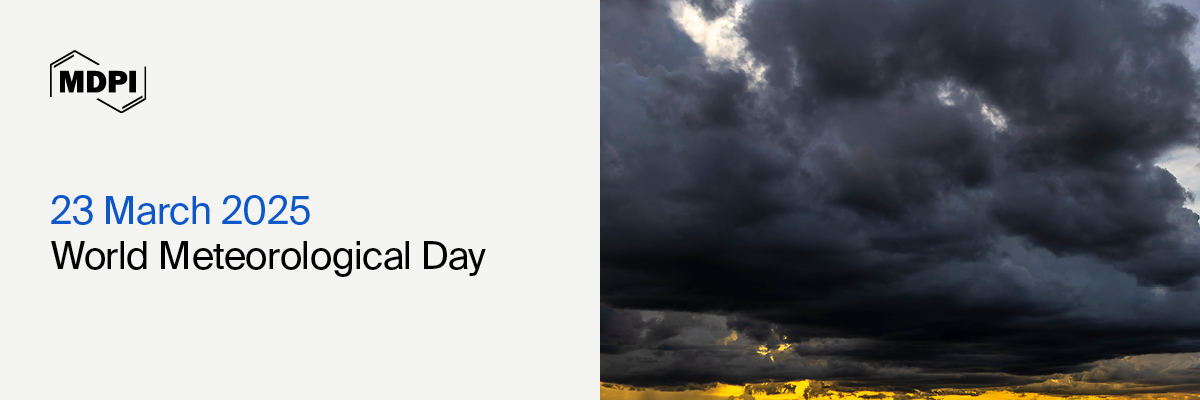Announcements
21 March 2025
World Meteorological Day—“Closing the Early Warning Gap Together”, 23 March 2025

You are accessing a machine-readable page. In order to be human-readable, please install an RSS reader.
All articles published by MDPI are made immediately available worldwide under an open access license. No special permission is required to reuse all or part of the article published by MDPI, including figures and tables. For articles published under an open access Creative Common CC BY license, any part of the article may be reused without permission provided that the original article is clearly cited. For more information, please refer to https://www.mdpi.com/openaccess.
Feature papers represent the most advanced research with significant potential for high impact in the field. A Feature Paper should be a substantial original Article that involves several techniques or approaches, provides an outlook for future research directions and describes possible research applications.
Feature papers are submitted upon individual invitation or recommendation by the scientific editors and must receive positive feedback from the reviewers.
Editor’s Choice articles are based on recommendations by the scientific editors of MDPI journals from around the world. Editors select a small number of articles recently published in the journal that they believe will be particularly interesting to readers, or important in the respective research area. The aim is to provide a snapshot of some of the most exciting work published in the various research areas of the journal.
Original Submission Date Received: .

Every 23 March, the World Meteorological Organization commemorates the coming into force of the convention establishing the World Meteorological Organization on 23 March 1950. This day highlights the critical role of meteorology in understanding and addressing global challenges, particularly the urgent threat of climate change. Climate change is a real and undeniable crisis that poses significant risks to our civilization. Its effects—rising temperatures, extreme weather events, and shifting climate patterns—are already visible and will have catastrophic consequences if immediate action is not taken.
The theme for World Meteorological Day 2025, “Closing the Early Warning Gap Together”, emphasizes the importance of collaboration in strengthening early warning systems to protect vulnerable communities from climate-related disasters. Early warnings save lives, reduce economic losses, and empower societies to adapt to a changing climate. However, significant gaps remain in global coverage, particularly in developing regions.
Inspired by this mission and reflecting in line with Goal 13 of the SDG Publishers Compact: Climate Action, MDPI’s established journals in the environmental and Earth sciences field serve as vital platforms for scientific communication. By sharing cutting-edge research and practical solutions, MDPI contributes to global efforts to close the early warning gap and build a more climate-resilient world.
Join us in celebrating World Meteorological Day 2025 and supporting initiatives that strengthen early warning systems and address the impacts of climate change. Together, we can work toward a future where communities are better prepared, informed, and protected from the growing threats of a changing climate.


Invited speakers:
|
|
Prof. Dr. Bruce McCarl, Texas A&M University, USA Presentation: “Agriculture in the Climatic Squeeze: Economic Analysis and Thoughts on Preparation for Shocks” |
|
|
Dr. A. K. M. Azad Hossain, University of Tennessee at Chattanooga, USA Presentation: “Understanding the Historical Dynamics of Water Quality Using Remote Sensing” |
|
|
Prof. Dr. Akira Tokuhiro, Ontario Tech University, Canada Presentation: “Days of Future Past” |
Feel free to register for this webinar here!

|
Environmental & Earth Sciences |
Engineering |
|
|
||
|
|
||
|
|
||
|
Social Science, Art and Humanities |
||
|
|
||
|
|
|

“Establishing an Early Warning System for Dust Storms in Peri-Desert Regions”
by Aishajiang Aili, Abdul Waheed, Xinfeng Zhao and Hailiang Xu
Environments 2024, 11(4), 61; https://doi.org/10.3390/environments11040061
“The Quality Urban Label and the 4Q City Model: Levers for Urban Adaptation and Climate Change Mitigation in Mediterranean Cities”
by Jordi Mazon
Urban Sci. 2024, 8(4), 228; https://doi.org/10.3390/urbansci8040228
“Forecasting Convective Storms Trajectory and Intensity by Neural Networks”
by Niccolò Borghi, Giorgio Guariso and Matteo Sangiorgio
Forecasting 2024, 6(2), 326-342; https://doi.org/10.3390/forecast6020018
“Decoding the Atmosphere: Optimising Probabilistic Forecasts with Information Gain”
by John R. Lawson, Corey K. Potvin and Kenric Nelson
Meteorology 2024, 3(2), 212-231; https://doi.org/10.3390/meteorology3020010
“Climate-Change-Driven Droughts and Tree Mortality: Assessing the Potential of UAV-Derived Early Warning Metrics”
by Ewane Basil Ewane, Midhun Mohan, Shaurya Bajaj, G. A. Pabodha Galgamuwa, Michael S. Watt, Pavithra Pitumpe Arachchige, Andrew T. Hudak, Gabriella Richardson, Nivedhitha Ajithkumar, Shruthi Srinivasan et al.
Remote Sens. 2023, 15(10), 2627; https://doi.org/10.3390/rs15102627
“Features of Soil Organic Carbon Transformations in the Southern Area of the East European Plain”
by Fedor N. Lisetskii, Zhanna A. Buryak, Olga A. Marinina, Pavel A. Ukrainskiy and Pavel V. Goleusov
Geosciences 2023, 13(9), 278; https://doi.org/10.3390/geosciences13090278
“Exact Expressions for Lightning Electromagnetic Fields: Application to the Rusck Field-to-Transmission Line Coupling Model”
by Vernon Cooray, Gerald Cooray, Marcos Rubinstein and Farhad Rachidi
Atmosphere 2023, 14(2), 350; https://doi.org/10.3390/atmos14020350


 |
Environ. Earth Sci. Proc., 2023, ECAS 2023 The 6th International Electronic Conference on Atmospheric Sciences |

